How to waterproof your hiking boots
When it comes to waterproofing, each type of footwear has its own requirements, which vary according to the material it is made of. Let's take a look at the best practices for waterproofing hiking boots.

Photo: alejandra_0049 on Pixabay
Dry feet guarantee comfort, limit the proliferation of bacteria and the risk of blisters... and the advantage is that you are warm when your feet are dry! Making sure your hiking boots are waterproof is therefore essential. Whether it's for a trek lasting several days in the high mountains or a few hours on the plains, you are never safe from a rain shower or a stream to cross. Although most hiking boots are pre-coated with a durable water-repellent system, regardless of the material, it is still a good idea to re-waterproof them regularly, ideally after a good cleaning session. Let's find out together what good habits to adopt to guarantee the waterproofing of your hiking boots.
If there is one rule to follow when it comes to waterproofing hiking boots, it is to make sure that the product you are about to use is suitable for the main material of which the boots are made. Indeed, the treatment to be chosen will be different if the shoes are made of leather, nubuck or synthetic fabric. Here is a list of good practices and recommended care according to the material.
Before waterproofing your shoes, make sure they are perfectly clean.
For leather shoes
To waterproof your leather shoes you will need a cream or wax specifically designed for this purpose and adapted to smooth leather, as well as a piece of cloth or a small soft brush. Leather is a living material, so it needs to be nourished to prevent it from cracking and to keep it supple. This will reactivate the natural water repellency of the leather without damaging its breathability.
Using the cloth, apply the treatment evenly to the entire surface of the shoe, including the tongue. You can gently rub the cloth over the shoe to ensure that the product penetrates the leather. If you find that the product does not penetrate properly, you can use a light blow-dryer to help it penetrate. Be careful! If your shoes have a Gore-Tex® membrane, avoid this step altogether.
Finally, leave to dry in the open air at room temperature, away from a direct heat source.
Don't forget that your shoes must maintain a certain amount of rigidity to ensure sufficient support for the foot and therefore your safety. This is why it is not advisable to perform this operation too often (one to a maximum of four times a year is sufficient), nor to use grease or shoe polish, which soften the leather too much and tend to reduce the waterproofing and breathability of the shoes.
For nubuck shoes
Nubuck is a leather finish that has undergone a special treatment that gives it a velvety feel, a bit like peach skin. Nubuck shoes therefore need special care to reactivate their water repellency. The specificity of the product to be used lies mainly in the application technique. There are waxes with the same active ingredients as those used for smooth leather, but they are liquid and can be applied with gas-free sprays, making it easier to distribute them so that the unique appearance of nubuck leather is preserved.
In detail, how do you waterproof your nubuck shoes?
- Clean your shoes thoroughly
- Apply the spray about 5cm from the shoe and evenly
- Leave to dry in a dry place, at room temperature, away from a direct heat source
- If you wish, a small brush stroke on dry and treated shoes will revive the peach skin aspect
For shoes made of synthetic fabrics
Unlike leather, which is naturally water-repellent, shoes made of synthetic fabric are not. It is therefore imperative to regularly check their water repellency to avoid unpleasant surprises. Once again, it is essential to constantly monitor the cleanliness of your shoes, which become damaged and age much more quickly if they are not properly maintained. Dust, mud and small debris damage the fabric through abrasion. To reactivate the water-repellent properties of your synthetic hiking boots, you can use special sprays to be applied generously and evenly. Finally, allow to dry at room temperature in a dry, ventilated area.
